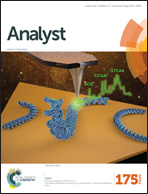Cooperative hydrogen-bonding of the adenine–thymine pair as a strategy for lowering the limit of detection of thymine by surface-enhanced Raman spectroscopy†
Abstract
The formation of cooperative hydrogen bonds between the thymine–adenine pair was used to indirectly determine thymine in aqueous solution by surface-enhanced Raman spectroscopy (SERS), therefore improving the limit of detection (LOD) values up to two orders of magnitude. The concentration of adenine was held constant and SERS spectra over gold nanoparticles were acquired through variable concentrations of thymine. The overall methodology followed a multivariate approach leading us to find the most suitable adenine concentrations to determine thymine and evidence the formation of new species whose response maintains a linear correlation with thymine nominal concentrations. Partial Least Squares (PLS) regression has been applied for modelling the data and close values of the root mean square error of cross-validation (RMSECV) and root mean square error of prediction (RMSEP) were obtained as indicators of model quality for modelling and prediction. The LOD for the thymine determination has been lowered from ∼20 to 0.278 mmol L−1 with a mean prediction error of 3.3%. It was verified that the improvement in LOD is only possible if the base pair is formed prior to the addition of the plasmonic nanoparticles. Finally, the assessment of the effect of an interference species introducing uracil to the system showed that it was possible to isolate the analyte response from the overall signals.



 Please wait while we load your content...
Please wait while we load your content...